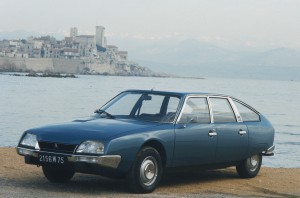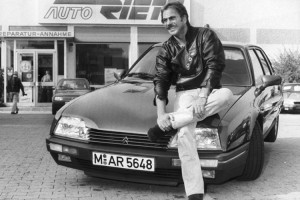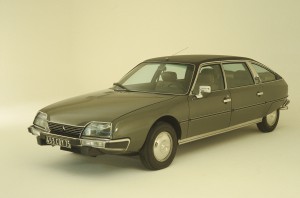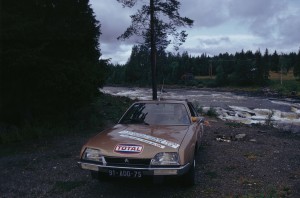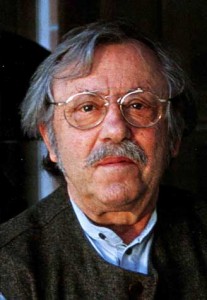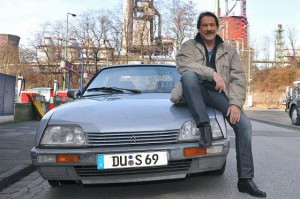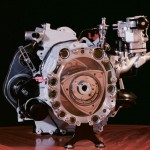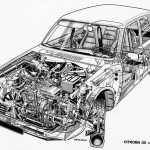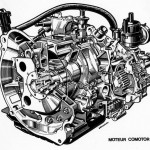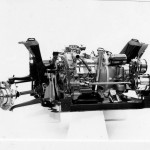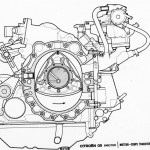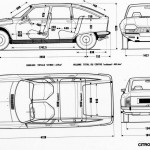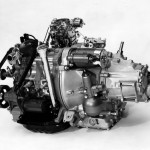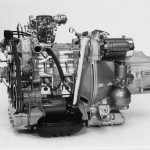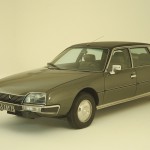
(English below, en Francais au-dessous)
Am 26. August 1974, also heute vor 40 Jahren, wurde der Citroën CX erstmals präsentiert. Als Nachfolger des legendären Citroën DS war das Modell der oberen Mittelklasse die Synthese aller technischen Entwicklungen von Citroën. In Deutschland wurden zwischen 1974 und 1991 insgesamt 111.049 Einheiten des Citroën CX verkauft. Besondere Bekanntheit erlangte der Citroën CX in den 80er Jahren in Deutschland als Dienstfahrzeug eines TV-Kriminalkommissars aus Duisburg.
Charmant und kostengünstig zugleich
Im Jahr 1969 kam das Startsignal für die Entwicklung eines Nachfolgers der DS-Modellreihe. Ziel war es, ein Fahrzeug zu schaffen, das an den Charme des seit 1955 produzierten Vorgängermodells anknüpfte, jedoch deutlich kostengünstiger herzustellen war.
Präsentiert wurde der Citroën CX dem französischen Staatspräsidenten Giscard d’Estaing kurz vor dem Pariser Salon 1974. Im Anschluss an die internationale Pressepräsentation in Lappland erhielten 25 Journalisten die Gelegenheit, mit dem Citroën CX an der „Raid Arctique“ teilzunehmen, die von Galliväre bei Kiruna rund 3000 Kilometer bei unterschiedlichsten Fahrbahnuntergründen und Wetterbedingungen bis nach Paris führte.
Der Name des Citroën CX geht auf den französischen Begriff für den Cw-Wert (Luftwiderstandswert) zurück. Der Cw-Wert des Citroën CX lag bei 0,39 und somit auf einem sehr guten Niveau.
Der Citroën CX galt als Synthese aller technischen Entwicklungen von Citroën. So verfügte er unter anderem über ein querliegendes Antriebsaggregat, hydropneumatische Federung mit konstanter Bodenfreiheit, Einzelradaufhängung, Scheibenbremsen an den Vorder- und Hinterrädern sowie eine Zweikreis-Servobremsanlage. Später kam noch die „Diravi“, eine geschwindigkeitsabhängige und selbstrückstellende Servolenkung hinzu. Die konkav gewölbte Heckscheibe – genau wie beispielsweise beim späteren „Flaggschiff“ Citroën C6 – ließ den Regen mittig ablaufen und erlaubte den Verzicht auf einen Heckwischer.
Die unter Leitung von Chefdesigner Robert Opron gestaltete Karosserie des Citroën CX orientierte sich nur geringfügig am Vorgängermodell DS. Lediglich die in ihrer Spurweite reduzierte Hinterachse und das Fließheck wurden stilistisch wieder aufgenommen.
Bewährte Motorisierungen
Beim Antrieb setzte man auf zwei bewährte Motorvarianten: Der Citroën CX 2000 übernahm den Motor des Citroën DS 20. Mit 1.985 cm3 und 102 PS (75 kW) erreichte das Fahrzeug eine Höchstgeschwindigkeit von 174 km/h. Der Citroën CX 2200 war mit einem des DSuper5 entnommenen Motors mit 2.175 cm3 und 112 PS (82 kW) ausgestattet, mit dem auf 179 km/h beschleunigt werden konnte.
„Auto des Jahres“ 1975
1975 wurde der Citroën CX zum „Auto des Jahres“ gekürt. Zudem erhielt er den „Prix de la Sécurité“ und den „Prix Style Award“. Im selben Jahr erschien der Citroën CX 2200 in der luxuriös ausgestatteten Variante „Pallas“. Kurz darauf war mit dem CX 2200 D das erste Dieseltriebwerk verfügbar, das bereits seit 1973 im Citroën C32 und C35 zum Einsatz kam.
Im September 1975 folgte die Kombi-Variante Citroën CX Break, die gegenüber der Limousine einen um 25 cm verlängerten Radstand aufwies. Den Break gab es auch als Familiale: ein Kombi mit dritter Rücksitzbank und Platz für bis zu acht Personen. Als zweite Neuerscheinung kam einige Monate später der Citroën CX Prestige auf den Markt, der 1977 mit einer elektronischen Benzineinspritzung aufwartete, was zu einer Leistungssteigerung auf 128 PS (94 kW) beziehungsweise 190 km/h führte.
Schnellster Pkw mit Dieselmotor
1978 wurde der Citroën CX optisch und mechanisch weiterentwickelt. Nach umfangreichen konzeptionellen Arbeiten am bestehenden Aggregat kam der Citroën CX 2500 D mit 75 PS (55 kW) auf den Markt. Mit diesem Antrieb konnte der Citroën CX mit 156 km/h den Titel als schnellster Pkw mit Dieselmotor beanspruchen.
Deutliches Facelift in 1985
Ab Juli 1985 war der Citroën CX stark optisch überarbeitet erhältlich – unter anderem mit Stoßfängern aus Plastik und Rundinstrumenten statt Walzentachos im Innenraum. Mit dem abermals überarbeiteten Turbodiesel-Motor und einer Spitzengeschwindigkeit von 195 km/h beanspruchte der Citroën CX erneut den Titel des weltweit schnellsten Diesel-Fahrzeugs.
Als Kombi, als Sondermodell und als Staatskarosse
Der Citroën CX Break diente aufgrund seiner Länge und seines Platzangebotes ohne Karosseriemodifikationen auch als Basis für Sonderlösungen – so zum Beispiel als Kranken- und Leichenwagen. Dank der hydropneumatischen Federung hatte der Citroën CX eine für einen Pkw sehr hohe Nutzlast von über 700 kg.
Die Luxusversion Citroën CX Prestige wurde von einigen Staatsoberhäuptern als Dienstwagen genutzt. So umfasste beispielsweise der Fuhrpark Erich Honeckers mehrere Citroën CX Prestige, die zusätzlich verlängert waren und Platz für eine dritte Sitzreihe boten.
Zwischen Spätsommer 1974 und 1989 wurden insgesamt 1.041.560 Einheiten der Baureihen Berline (Limousine) und 128.185 Break (Kombi) produziert.
Der Citroën CX Club in Deutschland (www.cx-club.de) beschäftigt sich mit der Erhaltung und Restauration des historischen Citroën Modells und gilt als fachkundiger Ansprechpartner bei Fragen zu Technik, Anschaffung und Wartung des Citroën CX.
Die Pressemitteilung der CDG im Original Download hier.
Und natürlich wollen wir ein Bild von “Kommissar Schimanski” mit seinem CX nicht vorenthalten:
Die Legende lebt – nicht zuletzt damit auch besonderer Dank an den damaligen Chefdesigner Robert Opron und sein Team, die diese Stil-Ikone geschaffen haben und die nun eine ständig wachsende Fangemeinde erfreut, die in tausenden Enthusiasten und diversen CX-Clubs weltweit organisiert ist! 🙂
—–
40 Years of Citroën CX
We are happy to share with you the press release by Citroën Germany on the anniversary of this iconic model, translation by Amicale:
On August 26 1974, today exactly 40 years ago, the Citroën CX was presented. As a successor to the legendary Citroën DS, the model of the upper middle class was the synthesis of all the technical developments of Citroën. In Germany a total of 111,049 units of the Citroën CX were sold from 1974 to 1991. The Citroën CX became famous in the 80s in Germany as a service vehicle of a famous TV Series.
Charming and inexpensive at the same time
In 1969 came the start signal for the development of a successor to the DS model. The aim was to create a vehicle, tying in to the charm of the previous model produced since 1955, but the objective was to have it significantly less expensive to produce.
The Citroën CX was presented to the French President Giscard d’Estaing just before the Paris Motor Show 1974, following the international press launch in Lapland to which 25 journalists were given the opportunity to participate with a Citroën CX in the “Raid Arctique” from Galliväre near Kiruna to ride approximately 3000 km in a wide variety of road surfaces and weather conditions towards Paris.
The name of the Citroën CX goes back to the French term for the drag coefficient. The drag coefficient of the Citroën CX was 0.39 and thus at a very good level.
The Citroën CX was considered a synthesis of all the technical developments of Citroën. So he decreed among other things, a transverse drive unit, hydro-pneumatic suspension with constant ground clearance, independent suspension, disc brakes on the front and rear wheels and a dual-circuit power brake system. Later on the “DIRAVI”, a speed-sensitive and self-resetting power steering, was introduced. The concave rear window – just like the later “flagship” Citroën C6 – let the rain run centrally, allowing the to skip a rear wiper.
The designed of the Citroën CX was executed under the direction of chief stylist Robert Opron was following only slightly on the previous model DS. Only the reduced track-width of the rear axle and the hatchback style was taken over to some extent.
Proven Engines
Two proven engine variants were delivered at first: the Citroën CX in 2000 took over the engine of the Citroën DS 20 with 1,985 cm3 and 102hp (75kW), allowing the vehicle to reach a top speed of 174km/h. The Citroën CX 2200 taking over from the the DSuper5 engine with 2,175 cm3 and 112hp (82kW) which could be accelerated up to a top speed of 179km/h.
“Car of the Year” in 1975
1975 Citroën CX was voted “Car of the Year”. It also received the “Prix de la Sécurité” and the “Prix Style Award”. That same year, the Citroën CX 2200 appeared as the luxurious variant “Pallas”. Shortly thereafter, with the CX 2200 D the first diesel engine was available which was used since 1973 in the models Citroën C32 and C35.
In September 1975, the station wagon variant Citroën CX Break followed which had an extended wheelbase of 25cm compared to the sedan. The break was also available as Familiale: a station wagon with the third rear seat row and offering room for up to eight people. The second new release came a few months later: the Citroën CX Prestige arrived on the market, which came up with an electronic injection in 1977, which led to an increase in power to 128hp (94kW) and a top speed of 190km/h.
Fastest cars with diesel engines
1978 Citroën CX was optically and mechanically evolved. After extensive conceptual work on the existing aggregate, the Citroën CX 2500 D came with 75hp (55kW) to the dealerships. With this drive and a top speed of 156km/h, the Citroën CX could claim the title as being the fastest car with diesel engine.
Significant facelift in 1985
As of July 1985, the Citroën CX was undergoing another larger evolution – including plastic bumpers and round dials instead of rolling speedometer in the interior. By an again revised turbo diesel engine allowing a top speed of 195km/h, the Citroën CX could again claim the title of being the world’s fastest diesel vehicle.
Available as estate car, special conversions and as presidential limousine
The Citroën CX Break served due to its length and available space without body modifications as the basis for many customized bodyworks – for example as a ambulance and hearses. Thanks to the hydropneumatic suspension, the Citroën CX had very high payload of over 700kg.
The luxury version Citroën CX Prestige was used by some heads of state as a presidential limousine. So, for example, Eastern Germany’s Erich Honecker used several Citroën CX Prestige, which were also extended and offered space for a third row of seats.
Between late summer 1974 and 1989 a total of 1,041,560 units of the series Berline (sedan) and 128,185 Break (station wagon) were produced.
The Citroën CX Club in Germany (www.cx-club.de) deals with the preservation and restoration of historic Citroën model and is considered an expert contact for questions about technology, acquisition and maintenance of the Citroën CX.
—
Please fetch the original press release of Citroën Germany here (German spoken only, sorry).
NB: We are also happy to notice that the company press release also addresses a club reference – the cooperation with Citroën, Amicale and the clubs once again proves an active and agile partnership. Well done! 🙂
And – of course – a big “thank you” to M. Robert Opron and his team to have realized such an iconic automotive legend which attracts a constantly growing number of thousands of enthusiasts organized in clubs worldwide towards this outstanding Citroën model… 🙂
—–
40 ans de la Citroën CX
Nous sommes heureux de partager avec vous le communiqué de presse de Citroën Allemagne pour l’anniversaire de ce modèle emblématique, la traduction par l’Amicale:
Le 26 Août 1974, aujourd’hui il ya exactement 40 ans avant, la Citroën CX etait présenté. En tant que successeur de la légendaire Citroën DS, le modèle de la classe moyenne supérieure est la synthèse de tous les développements techniques de Citroën. En Allemagne, un total de 111,049 unités de la Citroën CX etaient vendus de 1974 à 1991. La Citroën CX est devenu célèbre dans les années 80 en Allemagne en tant que véhicule de service d’une célèbre série en TV, “Commissaire Schimanski”.
Le communiqué de presse de Citroën Allemagne pour télécharger ici (en Allemand, desolé).
Nous sommes aussi heureux que la coopération avec le fabricant et la coopération active avec les clubs et l’Amicale Citroën Deutschland peut être placé sous la preuve à nouveau dans le texte – la reference au club Citroën CX en R.F.A. est integré – et le (www.cx-club.de) est la meilleure adresse pour cette icone roulante chez nous…
Et – personellement – aussi un grand “Merci” a M. Robert Opron pour realiser un dessin et style légendaire, celebré par 1000s de l’enthousiastes du monde 🙂


